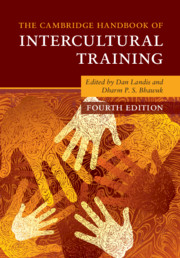Book contents
- The Cambridge Handbook of Intercultural Training
- Reviews
- The Cambridge Handbook of Intercultural Training
- Copyright page
- Dedication
- Frontispiece
- Contents
- Figures
- Tables
- Editors and Contributors
- Foreword
- Preface
- 1 Introduction and Theoretical Framework
- Part I Theoretical Foundations of Intercultural Training
- Part II Practice of Intercultural Training
- Part III Indigenous Psychology and Intercultural Training
- 15 Brazilian Cultural Patterns and Intercultural Training
- 16 Russian Cultural Patterns and Intercultural Training
- 17 Indian Psychology and Intercultural Training
- 18 Culture-Inclusive Theories for Intercultural Training in Confucian Societies
- 19 Japanese Psychology and Intercultural Training
- Part IV New Interdisciplinary Approaches to Intercultural Training
- Part V Summing Up
- Index
- References
18 - Culture-Inclusive Theories for Intercultural Training in Confucian Societies
An In-Depth Analysis of Face Dynamism
from Part III - Indigenous Psychology and Intercultural Training
Published online by Cambridge University Press: 18 September 2020
- The Cambridge Handbook of Intercultural Training
- Reviews
- The Cambridge Handbook of Intercultural Training
- Copyright page
- Dedication
- Frontispiece
- Contents
- Figures
- Tables
- Editors and Contributors
- Foreword
- Preface
- 1 Introduction and Theoretical Framework
- Part I Theoretical Foundations of Intercultural Training
- Part II Practice of Intercultural Training
- Part III Indigenous Psychology and Intercultural Training
- 15 Brazilian Cultural Patterns and Intercultural Training
- 16 Russian Cultural Patterns and Intercultural Training
- 17 Indian Psychology and Intercultural Training
- 18 Culture-Inclusive Theories for Intercultural Training in Confucian Societies
- 19 Japanese Psychology and Intercultural Training
- Part IV New Interdisciplinary Approaches to Intercultural Training
- Part V Summing Up
- Index
- References
Summary
As a crucial concept for understanding Chinese social behavior, face derives from the complicated structure of Confucianism and has continued to develop as a consequence of modernization. This chapter aims to present a series of culture-inclusive theories from the psychological perspective to illustrate face dynamism in Chinese societies. Specifically, the aims of this chapter are threefold: First, to present culture-inclusive theories of face dynamism in Chinese societies as potential materials for intercultural training related to social interactions with the Chinese. Second, to present a glossary of face-related concepts, each defined and reinterpreted in the context of current culture-inclusive theories, and to illustrate their usage as language games by Chinese people in daily social interactions. Third, the discussion of face extends from the interpersonal level to the international level, in order to highlight its cultural significance in intercultural interactions with the Chinese. We focus on the most significant and unique cultural element during intercultural interactions with the Chinese, namely face, by illustrating various roles it plays in Chinese societies. From traditional to modern usage, from personal to national level, we hope that the discussions will shed light on the why and how of face in Chinese social interactions.
- Type
- Chapter
- Information
- The Cambridge Handbook of Intercultural Training , pp. 564 - 583Publisher: Cambridge University PressPrint publication year: 2020
References
- 1
- Cited by



